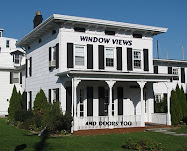
We often have these beautiful birds of prey at the Airport. They love to snack on pigeons and other tidbits that roam and roost adjacent to the Airport perimeter. I have to admit that these are probably one of my favorite birds. Please check out That's My World where people from all over the world share pictures of their part of the world.
The Red-tailed Hawk (Buteo jamaicensis) is a medium-sized bird of prey, one of three species colloquially known in the United States as the "chickenhawk," though it rarely preys on chickens. It breeds throughout almost all North America from western Alaska and northern Canada to as far south as Panama and the West Indies, and is one of the most common buteos in North America. There are fourteen recognized subspecies, which vary in appearance and range. It is one of the largest members of the genus Buteo in North America, typically weighing from 690 to 1600 grams (1.5 to 3.5 pounds) and measuring 45–65 cm (18 to 26 in) in length, with a wingspan from 110 to 145 cm (43 to 57 in). The Red-tailed Hawk displays sexual dimorphism in size, as females are about 25% heavier than males.
 A male Red-tailed Hawk may weigh from 690 to 1300 grams (1.5 to 3.5 pounds) and measure 45–56 cm (18 to 22 in), while a female can weigh between 900 and 2000 grams (2 and 4.4 pounds) and measure Body size, 18 to 26 in (45 to 65 cm); Wingspan,is about 3.8 to 4.3 (1.1 to 1.3 m) (20 to 26 in) in length. As is the case with many raptors the Red-tailed Hawk displays sexual dimorphism in size, as females are 25% larger than males. The wingspan is from 110 to 145 cm (43 to 57 in).
A male Red-tailed Hawk may weigh from 690 to 1300 grams (1.5 to 3.5 pounds) and measure 45–56 cm (18 to 22 in), while a female can weigh between 900 and 2000 grams (2 and 4.4 pounds) and measure Body size, 18 to 26 in (45 to 65 cm); Wingspan,is about 3.8 to 4.3 (1.1 to 1.3 m) (20 to 26 in) in length. As is the case with many raptors the Red-tailed Hawk displays sexual dimorphism in size, as females are 25% larger than males. The wingspan is from 110 to 145 cm (43 to 57 in).Red-tailed Hawk plumage can be variable, depending on the subspecies and the region. These color variations are morphs, and are not related to molting.
The western North American population, B. j. calurus, is the most variable subspecies and has three color morphs: light, dark, and intermediate or Rufus. The dark and intermediate morphs constitute 10–20% of the population.
Though the markings and hue vary, the basic appearance of the Red-tailed Hawk is consistent. The underbelly is lighter than the back and a dark brown band across the belly, formed by vertical streaks in feather patterning, is present in most color variations. The red tail, which gives this species its name, is uniformly brick-red above and pink below.The bill is short and dark, in the hooked shape characteristic of raptors. The cere, the legs, and the feet of the Red-tailed Hawk are all yellow.
Immature birds can be readily identified at close range by their yellowish irises. As the bird attains full maturity over the course of 3–4 years, the iris slowly darkens into a reddish-brown hue. In both the light and dark morphs, the tail of the immature Red-tailed Hawk are patterned with numerous darker bars.
 In flight, this hawk soars with wings in a slight dihedral, flapping as little as possible to conserve energy. Active flight is slow and deliberate, with deep wing beats. In wind, it occasionally hovers on beating wings and remains stationary above the ground. When soaring or flapping its wings, it typically travels from 20 to 40 mph (64 km/h), but when diving may exceed 120 mph (190 km/h). When the Red-tailed Hawk walks, its steps are slow and awkward.
In flight, this hawk soars with wings in a slight dihedral, flapping as little as possible to conserve energy. Active flight is slow and deliberate, with deep wing beats. In wind, it occasionally hovers on beating wings and remains stationary above the ground. When soaring or flapping its wings, it typically travels from 20 to 40 mph (64 km/h), but when diving may exceed 120 mph (190 km/h). When the Red-tailed Hawk walks, its steps are slow and awkward. The Red-tailed Hawk is generally non-aggressive toward people and toward other birds. It is commonly harassed by crows, magpies, owls, other hawks, and even songbirds over territorial disputes, though it is generally not injured. When threatened by a human intruder, a Red-tailed Hawk will generally flee rather than defend its nest.
The cry of the Red-tailed Hawk is a two to three second hoarse, rasping scream, described as kree-eee-ar, which begins at a high pitch and slurs downward. This cry is often described as sounding similar to a steam whistle. It frequently vocalizes while hunting or soaring, but vocalizes loudest in annoyance or anger, in response to a predator or a rival hawk's intrusion into its territory. At close range, it makes a croaking "guh-runk". Young hawks may utter a wailing klee-uk food cry when parents leave the nest.
Because of its robust crispness, a certain recording of the cry of the Red-tailed Hawk is a cliché cinematic sound effect. This high, piercing scream is often featured in the background of adventure movies to give a sense of wilderness to the scene. However, the cry is often inaccurately used for the Bald Eagle, whose own vocalizations are quite different and less robust.
 The Red-tailed Hawk is carnivorous, and an opportunistic feeder. Its diet is mainly small mammals, but it also includes birds and reptiles. Prey varies with regional and seasonal availability, but usually centers on small rodents. Additional prey include rabbits, snakes, waterfowl, bats, shrews, crustaceans, insects, rodents, and fish.
The Red-tailed Hawk is carnivorous, and an opportunistic feeder. Its diet is mainly small mammals, but it also includes birds and reptiles. Prey varies with regional and seasonal availability, but usually centers on small rodents. Additional prey include rabbits, snakes, waterfowl, bats, shrews, crustaceans, insects, rodents, and fish. The Red-tailed Hawk hunts primarily from an elevated perch site, swooping down from a perch to seize prey, catching birds while flying, or pursuing prey on the ground from a low flight.
Prey range in size from beetles to White-tailed Jackrabbits, which are double the weight of most Red-tails. In captivity in winter, an average Red-tail will eat about 135 g (4-5 oz) daily.The Great Horned Owl occupies a similar ecological niche nocturnally, taking similar prey. Competition may occur between the Red-tailed Hawk and the Great Horned Owl during twilight.
The Red-tailed Hawk reaches sexual maturity at two years of age. It is monogamous, mating with the same individual for many years. In general, the Red-tailed Hawk will only take a new mate when its original mate dies. The same nesting territory may be defended by the pair for years. During courtship, the male and female fly in wide circles while uttering shrill cries. The male performs aerial displays, diving steeply, and then climbing again. After repeating this display several times, he sometimes grasps her talons briefly with his own. Courtship flights can last 10 minutes or more. Copulation often follows courtship flight sequences, although copulation frequently occurs in the absence of courtship flights.
In copulation, the female, when perched, tilts forward, allowing the male to land with his feet lodged on her horizontal back. The female twists and moves her tail feathers to one side, while the mounted male twists his cloacal opening around the to the female's cloaca. Copulation lasts 5 to 10 seconds and during pre-nesting courtship in late winter or early spring can occur numerous times each day.
In the same period, the pair constructs a stick nest in a large tree 4 to 21 m off the ground or on a cliff ledge 35 m (115 ft) or higher above the ground, or may nest on man-made structures. The nest is generally 71 to 97 cm (28 to 38 inches) in diameter and can be up to 90 cm (3 ft) tall. The nest is constructed of twigs, and lined with bark, pine needles, corn cobs, husks, stalks, aspen catkins, or other plant lining matter.
Great Horned Owls compete with the Red-tailed Hawk for nest sites. Each species has been known to kill the young and destroy the eggs of the other, but in general, both species nest in adjacent or confluent territories without conflict. Great Horned Owls are incapable of constructing nests and typically expropriate existing Red-tail nests. Great Horned Owls begin nesting behaviors much earlier than Red-tails, often as early as December. Red-tails are therefore adapted to constructing new nests when a previous year's nest has been overtaken by owls or otherwise lost. New nests are typically within a kilometer or less of the previous nest. Often, a new nest is only a few hundred meters or less from a previous one.
A clutch of 1 to 3 eggs is laid in March or April, depending upon latitude. Clutch size depends almost exclusively on the availability of prey for the adults. Eggs are laid approximately every other day. The eggs are usually about 60 x 47 mm (2.4 x 1.9 in). They are incubated primarily by female, with the male substituting when the female leaves to hunt or merely stretch her wings. The male brings most food to the female while she incubates. After 28 to 35 days, the eggs hatch over 2 to 4 days; the nestlings are altricial at hatching. The female broods them while the male provides most of the food to the female and the young, which are known as eyasses (pronounced "EYE-ess-ess"). The female feeds the eyasses after tearing the food into small pieces. After 42 to 46 days, the eyasses begin to leave the nest on short flights. The fledging period lasts up to 10 weeks, during which the young learn to fly and hunt. (excerpts taken from Wikipedia)






























.jpg)


40 comments:
what a super series of photos.
You were asking about the bread sauce it is smooth, like bread soaked in milk. You should try it, it really is good with the turkey.
Gill in Canada
Erin: Very nice captures of the red tail at your airport.
What brilliant pics of one of natures marvels. Thanks for teaching me something new today.
Great photos and most informative post.
Wow fantastic close up shots of the eagle. I dont have the luck or patience to take photography of bird...lol. They are too quick for me.
How majestic
Great shots of the Red-tail with wonderful information!
Very nice captures,i like it.
Thanks for the visit of my blog.
Have a nice day.
Wow, wonderful shots! I'm kind of smiling about when you said they "snack on pigeons". A pigeon is not small so that it would be a snack just seemed funny to me.
:-D
superbly brilliant captures and wonderful commentary too!!
A STUNNING series of photos with a very comprehensive narrative from which I've learned a lot. It's post like this that make this meme worthwhile. I get to learn something new each and every week. Thank you.
Beautiful birds, and what a look they have ! so proud !!
Very informative post. Beautiful shots taken. The hawk looks scary yet majestic.
Here in Niger, we are often visited by the "sparrow hawk", as it's called in Swedish - a very slim, elegant bird of prey. You never see him come as he just glides in unnoticed, but when you hear all the birds go dead silent, you know to look for him!her
He's a placid looking fellow!
We have a lot of RT Hawks around here, even in the winter. I have been able to get quite close to them several times. Your pictures are great and the information very interesting. I didn't know about the juveniles having yellow irises. That helps me ID the last one I took pictures of. Thanks for sharing!
Thanks for share so beautiful World.
What a wonderful and informative post! You can be proud of those fantastic photos. I am impressed, indeed!
Great photos - we had one of those live in our backyard one year and it was a fabulous opportunity to observe. Got to meet all the neighbors, too.
Beautiful capture! :)
Wow, these are superb up-close photos! If you don't mind, I would like to add you to my follow list on my blogger dashboard:) Jan
Love the hawk. Just discovered your blog and realized that we have reversed stories. I lived in Harrisonburg, Virginia for 6 years and recently moved to southern California. Fun stuff!
Hi- I'm here via Sky watch Fri, but oh what a treat to see these amazing macros of this hawk. Your informative post is as fascinating.
Very impressive !
A very great post with a lot of information and above all an impressive series of excellent photos! Thanks for sharing.
Wonderful photos of your hawk. And quite and in depth description of him too. I have a hawk in the backyard.
It is amazing how many variations there are of this species. They are, in my eyes, a north american icon, seen and heard by the eyes of many, perhaps even more so than the bald eagle.
Amazing! I am in awe. Beautiful! :-)
I looked through all your pictures, way into November. Felt a little nostalgic at the one or other image. Thank you for sharing your world with us!
Merry Christmas,
Happy Holidays! :-)
Great shots!! And very interesting facts by the way. Thanks for sharing!!
Nice photos. They are neat birds to watch. Thank you for sharing all the information on these beautiful birds.
These photos are stunning. I can't think how patient you must be to wait for the right moment to click...
The information was interesting too. I could do with one of these guys in my garden as we seem to be overrun with pigeons and magpies here.
Thanks for stopping by. Boy, it is hard to take a trip, plan Christmas, a Christmas party, and get sick, so that's why my reply is late.
Have a very, very Merry Christmas and a Happy New Year!
Raise a toast to VA bloggers!
Your shots are awsome.
This is fantastic! I learned so much about redtails from your post and loved it, and the photos are wonderful! Have you ever read the book Red Tails in Love, about the nesting pair in Central Park? It's an awesome book!
Glad you enjoy visiting my blog! I enjoy having you! Have a great Christmas!
Marie
Wow - these are great shots of the hawk. Just beautiful! Nice job. And thanks so much for all the info about them - you're wonderful!
Cracks me up that I've been befriended by someone so smart. :)
I learned just so I could pass my classes but learning wasn't something I've loved unless it had to do with crafting. LOL.
Great pics!!!! Thanks for sharing.
Amazingly good shots of the hawk! They do have a stern look, don't they?
I have never seen any birds in my yard or anything...only those in the aviary. Thats why I am grateful that I get to see a photo of a great bird by visiting other's blogs. Thanks for sharing! have a nice week!
So much information! And wonderful photos as well! I love seeing how the feathers overlap each other. Yes, I know they are supposed to do that, but seeing it is something else again. These photos are just special!
Thanks for sharing!
I am really enjoying going through your blog, looking at all your wonderful photos!
Red Tailed Hawks, I too love them. We had several stop by our house over the summer and from what I was able to capture on my camera, they were banded. Unfortunately I was never able to get the full #, but it was exciting none the less.
Sharon
Post a Comment